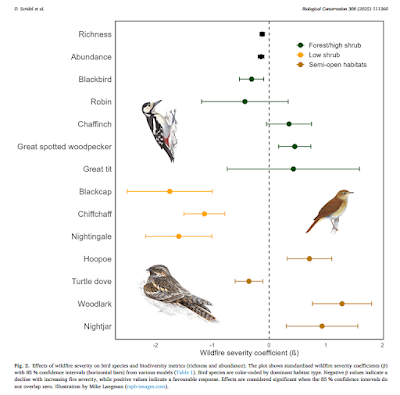Our study on the response of bird communities to the 2022 wildfire in the Karst is now published in Biological Conservation: Integrating remote sensing and species' traits to assess bird responses to wildfire in agropastoral landscapes. It is based on bird point counts that we designed and carried out in 2023 (first year after the fire) within a mixed voluntary group of Italian and Slovenian ornithologist in the trans-boundary Karst area.
In short, we found out that:
1) forest birds had a mixed response to the fire (some benefitting from it = Great Spotted Woodpecker, Great Tit, some suffering = Blackbird)
2) shrub species (Nightingale, Blackcap, Chiffchaff, Melodious Warbler) suffered the most
3) grassland/semi-open habitat species (Hoopoe, Woodlark, Nightjar) benefitted the most
1) forest birds had a mixed response to the fire (some benefitting from it = Great Spotted Woodpecker, Great Tit, some suffering = Blackbird)
2) shrub species (Nightingale, Blackcap, Chiffchaff, Melodious Warbler) suffered the most
3) grassland/semi-open habitat species (Hoopoe, Woodlark, Nightjar) benefitted the most
Also lots of other findings - check out the paper. Something more about this subject in one of our previous blogs.
 |
| Schematic results of our study |
 |
| Study area in the trans-boundary Karst between Slovenia and Italy. |
 |
| Black Woodpecker Dryocopus martius on charred black pine Pinus nigra |
 |
| Woodlark Lullula arborea in post-fire forest |
 |
| Rock Bunting Emberiza cia feeding in a charred black pine forest. |
 |
| Post-fire black pine forest in the Karst (Slovenia) |
 |
| Post-fire shrubland/grassland in the Karst (Slovenia) |

